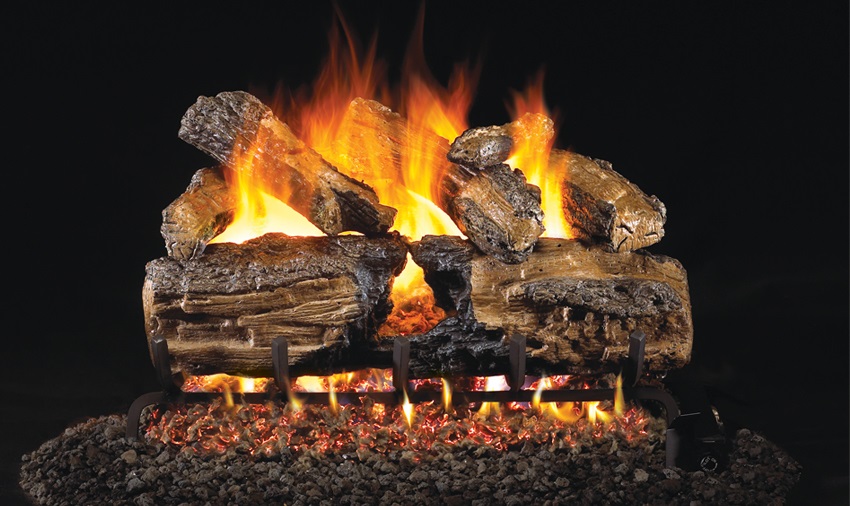When shopping for fireplaces, you will face many important decisions. One of the biggest is the type of logs. At first, this dilemma may not sound all that important, but you will quickly discover that not all fireplaces accommodate the same logs. This also means that the type of log you prefer will determine the type of fireplace you need.
There are two main categories of logs: wood and gas. Each has unique benefits that have made them popular. This article lays out the benefits of each log type so you can select the correct log - and fireplace - for you.
How Gas Logs and Wood Logs are Different
Gas logs look like wood logs but aren’t made of wood. They are usually made from ceramic fiber or a cement mixture. They don't burn like natural wood either; instead, they are designed to resemble the look of wood inside gas fireplaces and, in some cases, aid in radiating heat like real wood.
Gas fireplaces and wood fireplaces have different installation requirements, wood logs can never be burned in a gas fireplace.
Benefits of Gas Logs
Here are the top benefits of gas logs over real wood logs.
Convenience
Gas logs require little-to-no maintenance. You won’t need to chop and store the logs in large quantities, add more to the fire, or clean out the ashes.
Since gas logs are not made of wood, they also don’t break down as quickly. One gas log can last from 2 to 5 years, depending on the quality of the log. You maintain the same realistic wood appearance before and after your fire.
Benefits of Vented and Vent-Free Gas Logs
When choosing a gas log, you will need to select between vent-free or vented log designs. Each option brings certain benefits and only works with certain types of fireplaces.
Vent-Free Gas Logs
Also called ventless logs, vent-free logs are designed for a vent-free fireplace or a vented gas fireplace with a closed damper. Since no vent is required, these logs and fireplaces work great in locations where vent systems are challenging to install, such as in apartment buildings.
Vent-free logs are also highly energy efficient. They use 99% of the burned fuel while also radiating heat into your home, keeping you warmer while requiring less fuel.
If you use vent-free gas logs in a fireplace with a damper, keep it closed to maximize heat reflection.
Vented Gas Logs
These logs are used with externally vented systems (a chimney) that can burn real wood. Vented logs cannot be used in vent-free gas fireplaces because they release materials that must be exhausted up the chimney.
The main benefit of these logs is that they resemble the look and feel of burned wood better than vent-free logs. You can still improve the look of both log designs and the look of your fire with gas log accessories like pinecones, branches, and reflective backing on the fireplace, but vented logs create a more realistic flame and give off smoke like natural wood logs.
Since the logs require a chimney and damper, you can use your current non-gas chimney if you properly convert it to accommodate a gas fireplace system.
Benefits of Wood Logs
Wood logs have benefits that make them the better option for your needs. Here are some of the top benefits:
Engagement
Wood fires are naturally beautiful and engaging, as are gas fires. However, even though gas log designs have come a long way, you will still enjoy a more natural experience with real wood. The blend of scent, glow, crackle, and smoke sets it apart.
More Heat
Natural wood generates more heat than gas, which makes it a go-to option for heating larger rooms. Though gas has the benefit of added efficiency and heat control, wood logs are the ideal choice to bring on the heat.
You Support Renewable Energy
If you burn wood that grows naturally on your property, you can plant new trees as a replacement to ensure more wood for future years. Additionally, you can purchase firewood from companies that sell wood from regrowth trees. In both cases, you support renewable energy.
Your Fuel May be Free
If you live in a wooded area, you may have easy access to wood at little to no cost. Gas, on the other hand, must be purchased.
The Final Verdict
As you can see, gas and wood logs have benefits worth considering. Gas logs resemble the beauty and look of natural wood, but are more efficient, require far less maintenance, and are safer. You can also use them in a gas system inside your current wood-burning fireplace.
On the other hand, a wood fireplace brings maximum ambiance and the blend of odor, glow, and crackle of burned wood. Gas logs have improved significantly over the years, but a fire doesn’t get more natural than with real wood. You also have the option of free wood if there is plenty in your area, while also supporting renewable energy.


/1003/site-assets/logo.png)


